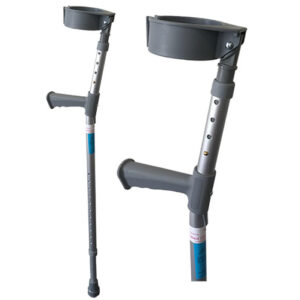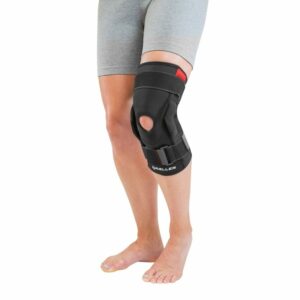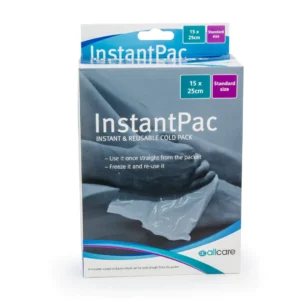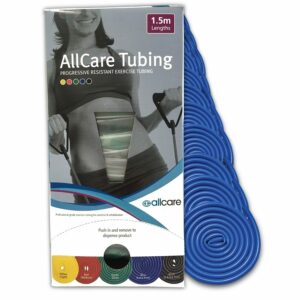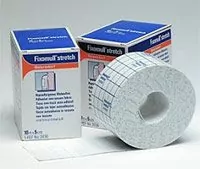MCL Tear
Updated:
(Also known as a MCL Injury, Medial Collateral Ligament Tear, Torn MCL, MCL Sprain, Sprained MCL, Ruptured MCL)
What is a MCL tear?
A MCL tear is a relatively common sporting injury affecting the knee and is characterized by tearing of the Medial Collateral Ligament of the knee (MCL).
A ligament is a strong band of connective tissue which attaches bone to bone. The MCL is situated at the inner aspect of the knee joint and is responsible for joining the inner aspect of the femur (thigh bone) to the inner aspect of the tibia (shin bone) (figure 1).
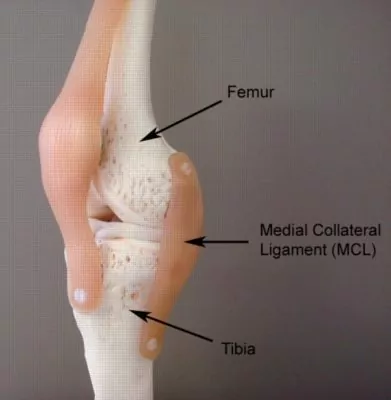
The MCL is one of the most important ligaments of the knee, giving it stability. The MCL achieves this role by preventing excessive twisting, and side to side movements of the knee (valgus forces – figure 2). When these movements are excessive and beyond what the ligament can withstand, tearing to the MCL occurs. This condition is known as a MCL tear.
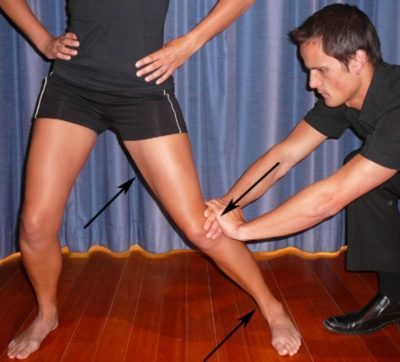
A MCL tear may range from a small partial tear resulting in minimal pain, to a complete rupture of the MCL resulting in significant pain and disability. A MCL tear can be graded as follows:
- Grade 1 tear: a small number of fibres are torn resulting in some pain but allowing full function
- Grade 2 tear: a significant number of fibres are torn with moderate loss of function.
- Grade 3 tear: all fibres are ruptured resulting in knee instability and major loss of function. Other structures may also be injured such as the menisci or cruciate ligaments.
Causes of a MCL tear
MCL tears typically occur during activities placing excessive strain on the MCL. This generally occurs suddenly due to a specific incident, however, occasionally may occur due to repetitive strain. There are two main movements that place stress on the MCL, these include:
- twisting of the knee
- valgus forces on the knee (figure 2)
When these movements (or combination of these movements) are excessive and beyond what the ligament can withstand, a MCL injury may occur.
MCL tears are frequently seen in contact sports or sports requiring rapid changes in direction. These may include: football, netball, basketball and downhill skiing. The usual mechanism of injury is a twisting movement when weight-bearing (especially when landing from a jump) or due to a collision to the outer knee, forcing the knee to bend in the wrong direction (such as another player falling across the outside of the knee). Occasionally a MCL injury may occur gradually due to repetitive activities such as breaststroke kicking when swimming.
Signs and Symptoms of a MCL tear
Patients with this condition may notice an audible snap or tearing sound at the time of injury. In minor cases of a MCL tear, patients may be able to continue activity only to experience an increase in pain, swelling and stiffness in the knee after activity with rest (particularly first thing in the morning). Often the pain associated with this condition is localized to the inner aspect of the knee.
In cases of a complete rupture of the MCL, pain is usually severe at the time of injury, however, may sometimes quickly subside. Patients may also experience a feeling of the knee going out and then going back in as well as a rapid onset of swelling (within the first few hours following injury). Patients with a complete MCL tear generally cannot continue activity due to pain or the knee feeling unstable. Occasionally, the patient may be unable to weight bear at the time of injury due to pain and may develop bruising and knee stiffness over the coming days.
Diagnosis of a MCL tear
A thorough subjective and objective examination from a physiotherapist is usually sufficient to diagnose a MCL tear. Investigations such as an X-ray, MRI scan or CT scan may be required to confirm diagnosis and determine the extent of damage or involvement of other structures within the knee.
Treatment for a MCL tear

Members Only ContentBecome a PhysioAdvisor Member to gain full access to this exclusive content. For more details see Become a Member. Already a member? Login Now
Prognosis of a MCL tear
With appropriate management, most patients with a minor to moderate MCL injury (grades 1 and 2) can return to sport or normal activity within 2 – 8 weeks. Patients with a complete rupture of the MCL will require a longer period of rehabilitation to gain optimum function. Patients with a MCL tear who also have damage to other structures of the knee such as the meniscus or collateral ligaments are likely to have an extended rehabilitation period.
Physiotherapy for a MCL tear
Physiotherapy for patients with this condition is vital to hasten the healing process, ensure an optimal outcome and reduce the likelihood of future recurrence. Treatment may comprise:
- soft tissue massage
- joint mobilization
- taping
- bracing
- ice or heat treatment
- electrotherapy (e.g. ultrasound)
- anti-inflammatory advice
- exercises to improve flexibility, strength and balance
- hydrotherapy
- education
- activity modification advice
- crutches prescription
- biomechanical correction
- a gradual return to activity program
Other intervention for a MCL tear
Despite appropriate physiotherapy management, a small percentage of patients with a MCL injury do not improve adequately. When this occurs the treating physiotherapist or doctor can advise on the best course of management. This may involve further investigation such as an X-ray, CT scan or MRI, or a review by a specialist who can advise on any procedures that may be appropriate to improve the condition. Surgical reconstruction of the MCL may be required in rare cases of a complete MCL rupture when conservative measures fail.
Exercises for a MCL tear
The following exercises are commonly prescribed to patients with this condition. You should discuss the suitability of these exercises with your physiotherapist prior to beginning them. Generally, they should be performed 3 times daily and only provided they do not cause or increase symptoms.
Your physiotherapist can advise when it is appropriate to begin the initial exercises and eventually progress to the intermediate and advanced exercises. As a general rule, addition of exercises should take place provided there is no increase in symptoms.
Initial Exercises
Knee Bend to Straighten
Bend and straighten your knee as far as possible and comfortable without increasing your pain (figure 3). Repeat 10 – 20 times provided there is no increase in symptoms.
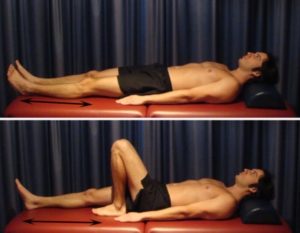
Static Quadriceps Contraction
Tighten the muscle at the front of your thigh (quadriceps) by pushing your knee down into a towel (figure 4). Put your fingers on your inner quadriceps to feel the muscle tighten during contraction. Hold for 5 seconds and repeat 10 times as hard as possible without increasing your symptoms.
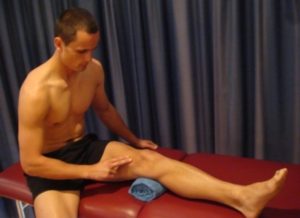
Intermediate Exercises

Members Only ContentBecome a PhysioAdvisor Member to gain full access to this exclusive content. For more details see Become a Member. Already a member? Login Now
Advanced Exercises

Members Only ContentBecome a PhysioAdvisor Member to gain full access to this exclusive content. For more details see Become a Member. Already a member? Login Now
Rehabilitation Protocol for a MCL tear

Members Only ContentBecome a PhysioAdvisor Member to gain full access to this exclusive content. For more details see Become a Member. Already a member? Login Now
Physiotherapy products for a MCL tear
Some of the most commonly recommended products by physiotherapists to hasten healing and speed recovery in patients with this condition include:
To purchase physiotherapy products for a medial collateral ligament tear click on one of the above links or visit the PhysioAdvisor Shop
Find a Physio
Find a physiotherapist in your local area to treat a medial collateral ligament tear .
More Information
- View more Knee Strengthening Exercises.
- View more Knee Stretches.
- View detailed information on How to use Crutches.
- View detailed information on when to use Ice or Heat.
Become a PhysioAdvisor Member

Link to this Page
If you would like to link to this article on your website, simply copy the code below and add it to your page:
<a href="https://physioadvisor.com.au/injuries/knee/mcl-tear”>MCL Tear – PhysioAdvisor.com</a><br/>PhysioAdvisor offers detailed physiotherapy information on a MCL tear and MCL injury including: symptoms, diagnosis, treatment, exercises, products and more...
Return to the top of MCL Tear.

